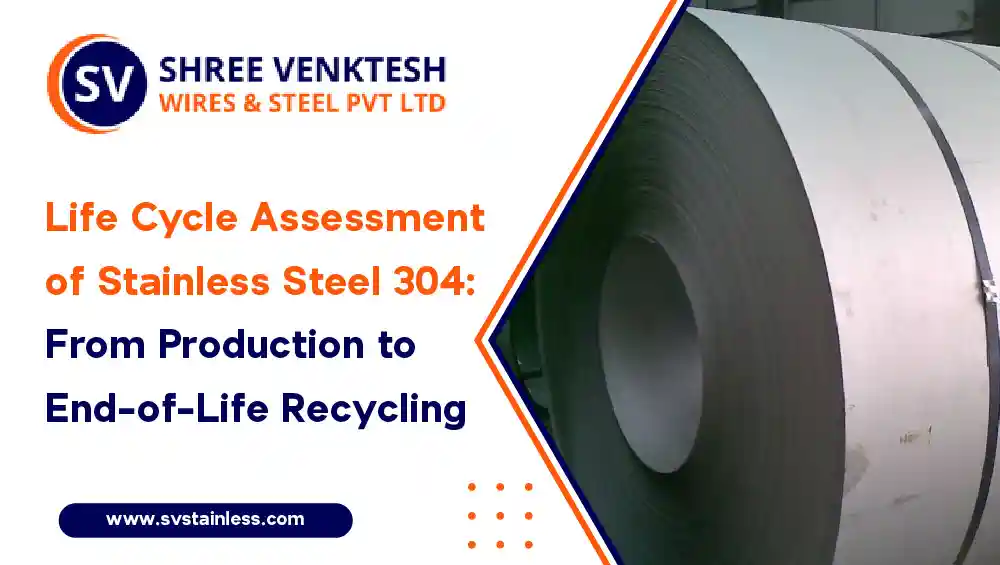
Life Cycle Assessment of Stainless Steel 304: From Production to End-of-Life Recycling
Stainless Steel 304, a popular and versatile material, has found its way into countless industries and applications due to its exceptional corrosion resistance, durability, and aesthetic appeal. However, in an era where sustainability and environmental responsibility are paramount, it's crucial to examine the life cycle of this material. In this comprehensive exploration, we will conduct a Life Cycle Assessment (LCA) of Stainless Steel 304, from its production to end-of-life recycling. We will delve into the environmental impact, resource utilization, and sustainability of this stainless steel alloy. Additionally, we will touch upon Shree Venktesh Wires and Steels Pvt Limited, a leading stockist and distributor of Jindal Stainless Ltd, showcasing the importance of responsible sourcing and distribution in the stainless steel industry.
Stainless Steel 304: An Overview
Stainless Steel 304 plates is a widely used stainless steel alloy known for its excellent corrosion resistance, strength, and versatility. It contains a significant amount of chromium (18%) and nickel (8%), which impart its corrosion-resistant properties. Stainless Steel 304 Sheets is commonly used in various applications, including construction, architecture, food processing, and transportation, among others.
Life Cycle Assessment (LCA) Methodology
A Life Cycle Assessment (LCA) is a comprehensive approach to evaluating the environmental impact of a product or material throughout its entire life cycle. The LCA process typically includes the following stages:
- Raw Material Acquisition: This stage assesses the extraction and processing of raw materials, such as iron ore and chromium, required for stainless steel production.
- Manufacturing: Evaluates the energy and resources consumed during the manufacturing process, including melting, casting, rolling, and finishing.
- Use Phase: Examines the environmental impact during the operational use of the product, considering factors like energy consumption and emissions.
- End-of-Life: Addresses the recycling, disposal, or other forms of product retirement and its associated environmental impact.
Production of Stainless Steel 304
The production of Stainless Steel 304 involves several energy-intensive processes, primarily in the manufacturing of raw materials and stainless steel production. Here's a closer look at the environmental impact during this stage:
- Raw Material Acquisition:
- Iron Ore Mining: The extraction of iron ore consumes energy and water, leading to habitat disruption and soil erosion.
- Chromium and Nickel Mining: Mining these metals also has environmental impacts, including habitat destruction and water pollution.
- Manufacturing:
- Melting and Casting: Stainless steel production involves the melting of raw materials in electric arc furnaces, consuming substantial energy.
- Rolling and Finishing: The hot rolling process consumes energy and results in greenhouse gas emissions.
- Chemical Processes: Pickling and passivation processes involve the use of chemicals, which can contribute to water pollution if not managed properly.
Use Phase of 304L Stainless Steel Sheet
The use phase of Stainless Steel 304 is where its environmental benefits shine. This alloy is known for its longevity, corrosion resistance, and low maintenance requirements. Its long service life reduces the need for frequent replacements, saving resources in the long run. Additionally, Stainless Steel 304 is fully recyclable, further enhancing its sustainability credentials.
End-of-Life Recycling
The end-of-life stage is a critical aspect of the LCA for Stainless Steel 304L. This alloy is highly recyclable, with a significant portion of stainless steel production coming from recycled material. Here's a breakdown of the end-of-life phase:
- Collection and Sorting:
- Stainless steel scrap is collected from various sources, including industrial waste, decommissioned structures, and discarded products.
- The scrap is sorted based on its composition and cleanliness, ensuring that only suitable material enters the recycling process.
- Melting and Recycling:
- The sorted stainless steel scrap is melted in electric arc furnaces, where it is alloyed with new materials to meet desired specifications.
- Recycling stainless steel requires less energy compared to primary production, resulting in reduced greenhouse gas emissions.
- Fabrication:
- The recycled stainless steel is formed into various products, such as Stainless Steel 304 Coils, Plates, and Sheets.
- These products are then distributed for use in various applications.
Environmental Benefits of Stainless Steel 304
Stainless Steel 304 plates offers several environmental benefits throughout its life cycle:
- Durability: Stainless Steel 304's long service life reduces the need for frequent replacements, conserving resources.
- Recyclability: The alloy is highly recyclable, with a significant portion of production coming from recycled material.
- Corrosion Resistance: Its corrosion resistance minimizes maintenance requirements, saving water and chemicals.
- Energy Efficiency: Stainless Steel 304's energy-efficient recycling process reduces greenhouse gas emissions.
Shree Venktesh Wires and Steels Pvt Limited: A Commitment to Responsible Sourcing
Shree Venktesh Wires and Steels Pvt Limited is a leading stockist and distributor of Jindal Stainless Ltd. Their prominence in the stainless steel industry highlights the importance of responsible sourcing and distribution. By partnering with reputable 304 stainless steel coil suppliers like Jindal Stainless Ltd, they ensure that their customers receive stainless steel products that meet stringent quality and sustainability standards.
Conclusion
The Life Cycle Assessment (LCA) of Stainless Steel 304L Coils reveals its environmental impact and sustainability throughout its life cycle. While its production involves energy-intensive processes, its exceptional durability, recyclability, and corrosion resistance make it an environmentally responsible choice. Stainless Steel 304L Plates, when sourced and used responsibly, aligns with the growing demand for sustainable materials in various industries. As demonstrated by Shree Venktesh Wires and Steels Pvt Limited, responsible sourcing and distribution play a crucial role in promoting sustainable practices within the stainless steel industry, ensuring that this valuable material continues to serve society's needs while minimizing its environmental footprint.

